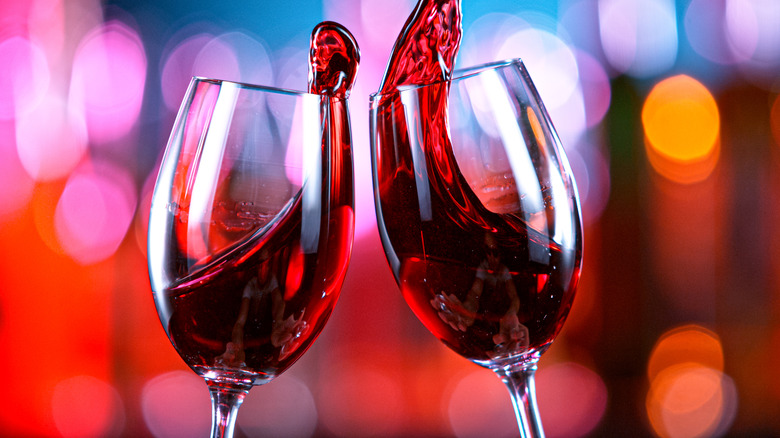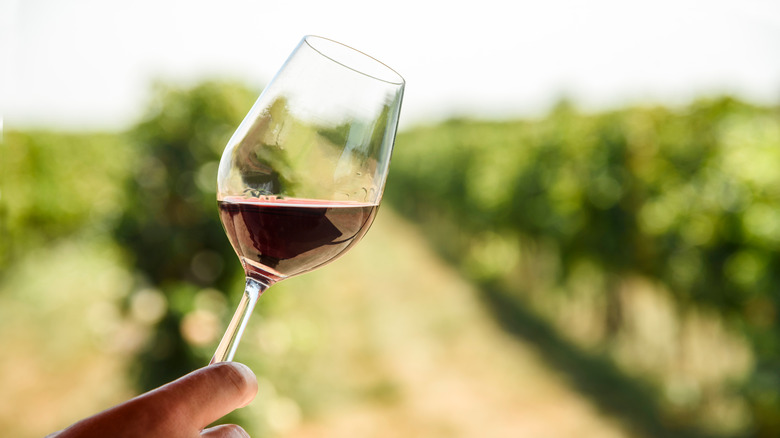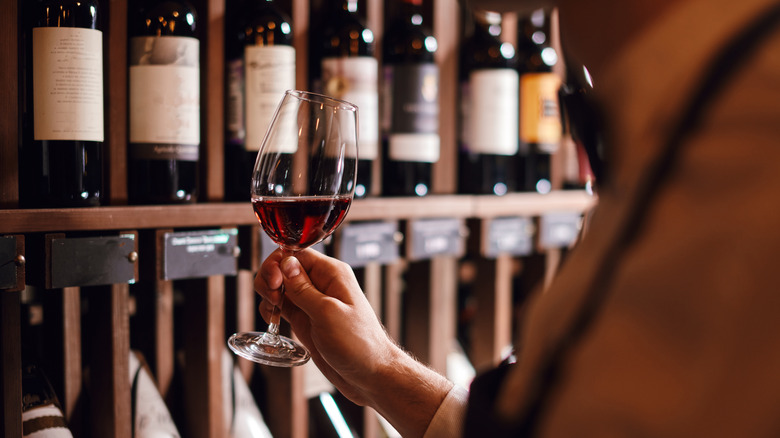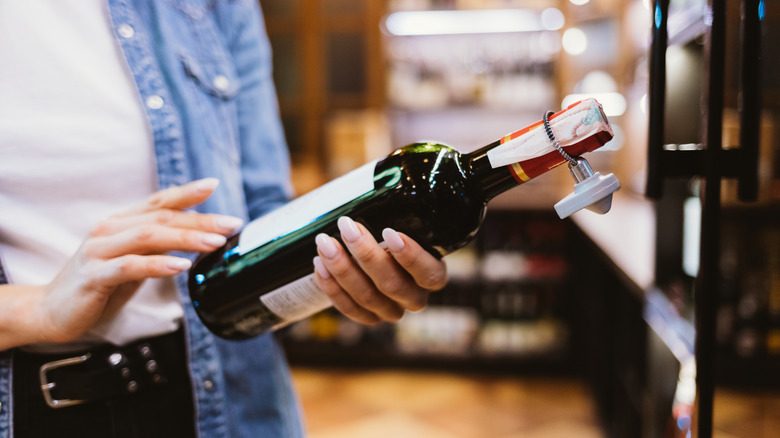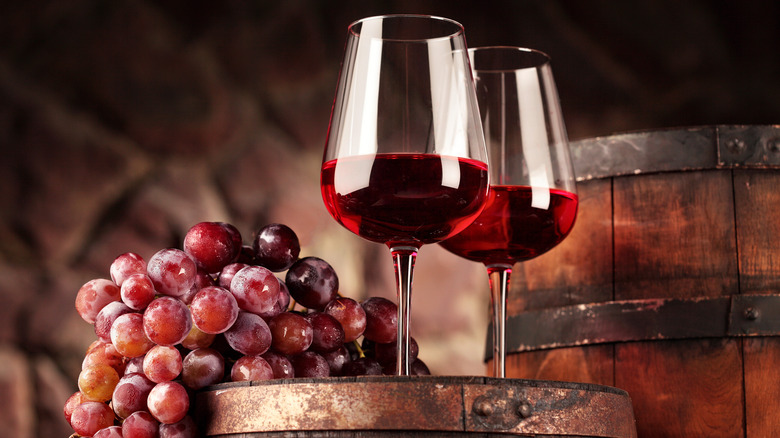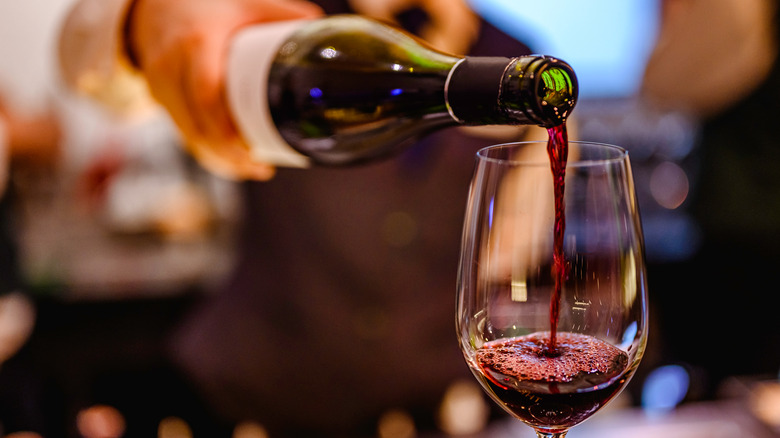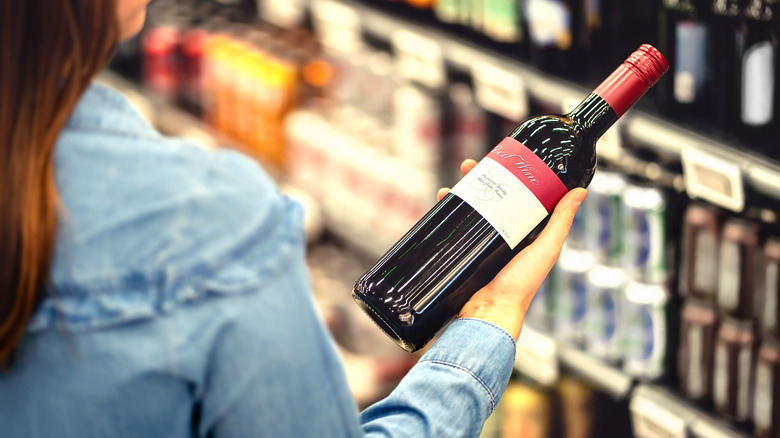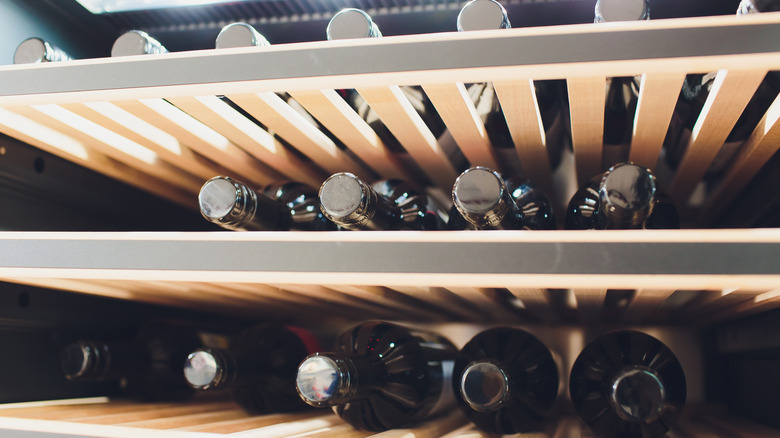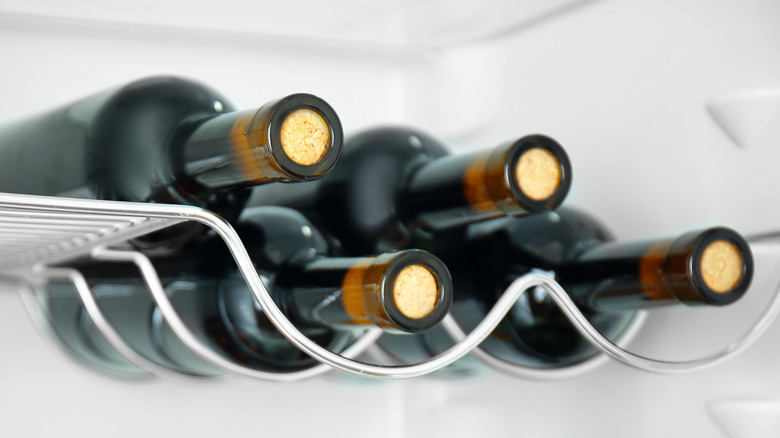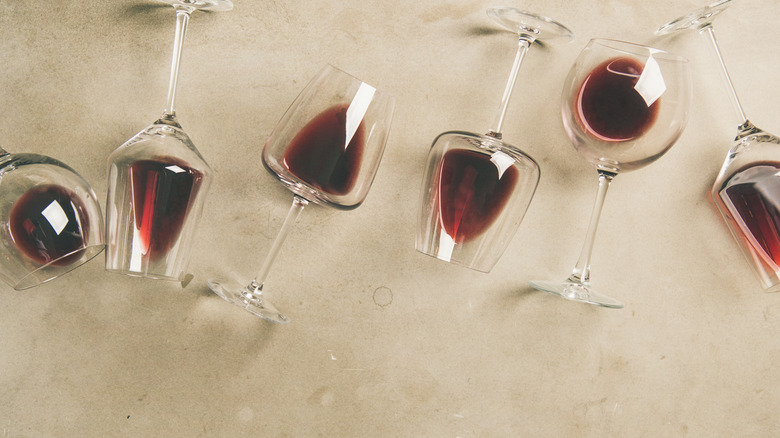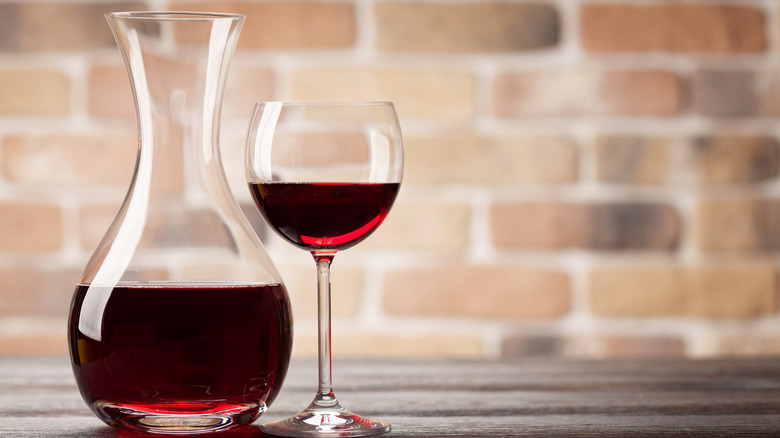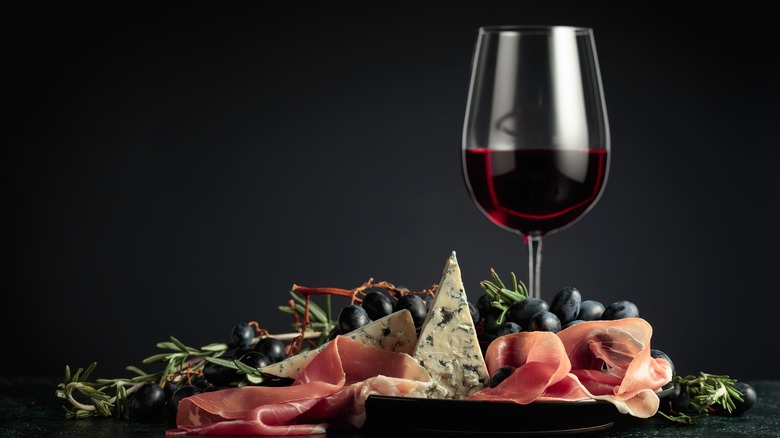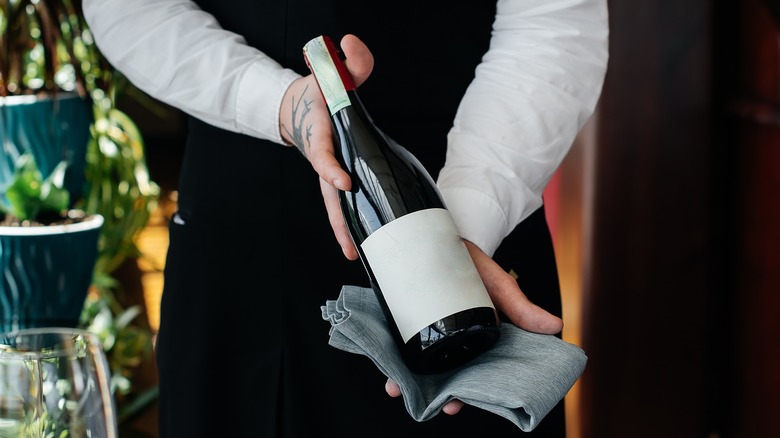12 Mistakes Everyone Makes When Drinking Red Wine
The wine world can be an intimidating place for beginners, and even experienced veterans occasionally find it hard to effortlessly navigate through the vast number of grape varieties and complicated regional appellations. Wine isn't meant to be scary and off-putting; on the contrary, it warmly welcomes anyone eager to sip on the boozy fermented grape juice.
When it comes to red wine, a survey conducted by National Today shows that it is the preferred choice for almost half of U.S. consumers. We often think of it as powerful, tannic, and opulent, but there are endless varieties and styles of red wine. From the rustic and dense reds brimming with earthy, oaky, and leather-like notes to the mouth-puckering juicy expressions dominated by berry-like flavors — regardless of their differences — they all fall into the same category.
Many elements of the wine process from purchase to service can affect your experience and perception of what you're drinking. This list can be used as a guide to eliminate misconceptions regarding red wine, avoid common serving mistakes, and broaden your knowledge. It will undoubtedly come in handy next time you pour a nice glass of red.
Sticking to only one variety and style
If you've been firmly staying within your comfort merlot zone, it's time to step outside the box. Although it's great to have a safe choice that doesn't let you down, there is an exciting world outside the familiar merlots and cabernets. The exact number of red grapes is hard to pin down, but estimates suggest that there are over 10,000 grape varieties (red and white) worldwide (via MasterClass).
If you want to stick to the same red variety every time, try investigating the different regions it's grown and exploring diverse styles. The Washington Post suggests replacing your Napa Valley cabernet sauvignon with ones from Washington state or trying some flavorful examples from South Australia. South America also offers excellent (and usually more affordable) renditions, primarily from Chile and Argentina. For great merlot, consider tasting lesser-known varieties with similar flavor profiles, such as Spanish mencía or saperavi, an ancient red grape from Georgia. Pinot noir lovers should not only rely on Burgundy, as there are great wines coming from places like Oregon, New Zealand, Australia, and Argentina.
Red wines have many personalities across all price ranges, so resist the urge to go for the same reliable option. Instead, take a risk with an unfamiliar bottle and you may very well discover a new favorite variety or a wine style that perfectly suits the occasion.
Not buying wine at specialty wine shops
Supermarkets are a precious modern commodity, but they aren't the top option for purchasing wine. For the best experience, always opt for a specialty wine shop, which offers the benefit of knowledgeable staff. You can ask for advice and receive suggestions, especially if you become a regular at a place with experienced and well-trained employees. Wine shops often have a niche in which they excel or simply do a decent job covering several major wine regions (via The Tennessean).
Vinepair gives insight into some helpful questions to ask in order to find a suitable bottle. Consider general inquiries about new products, innovative winemakers, and local wines, or get specific with pairing suggestions. Help the seller understand your preferences by sharing your favorite varieties and styles and asking for similar recommendations. Don't forget to use price range as a guideline; there's no need to splurge outside your means to find a nice bottle.
Though you might be able to get a better deal at a supermarket or liquor store, the experience at a wine shop will be more rewarding. Chances are that with the selection and assistance from staff, you'll end up with a bottle of red that better suits your taste.
Not examining the label thoroughly when buying wine
The wine world is a complex beast; even simple activities like reading wine labels can be overwhelming. Try to resist the urge to only choose bottles you find attractive, as the design itself is not an indicator of the quality and character of the wine.
Sommelier André Hueston Mack shares advice on how to get information about the contents by reading wine labels (via Bon Appétit). He explains that New World wines (from anywhere but Europe) often have playful labels and usually spell out the name of the grape variety. In contrast, Old World wines (from Europe) typically display the regional appellation — think Rioja, Bordeaux, or Chianti. In these cases, you need to know something about the geography to get an idea of what's inside the bottle as the grape variety is rarely identified.
Labels also display the vintage, which indicates the year the grapes were harvested. However, with standard everyday wines you aren't planning to cellar, the vintage doesn't really tell you much about quality. Meanwhile, inspecting the producer and importer can give you a hint about the quality if you are familiar with either. Still, location and grape variety will provide the best idea of what to expect in a bottle. Take a few extra minutes to read both the front and the back labels instead of just grabbing the flashiest bottle you see.
Believing that older red wines are always better
When it comes to red wines, there is a common preconception that good-quality bottles have to be aged and cellared. Though the rule applies to some bold wines that need time to rest before reaching their full potential, this naturally doesn't include every red wine. Not all grapes have the same ability to age, nor are all wines created equal.
Some styles are meant to be unpretentious, easy-drinking tipples with a thirst-quenching character that simply isn't meant to age. This doesn't mean that they are of lower quality; they just don't fit the same profile as powerful tannic reds that can be kept for decades. Currently, red wine trends are favoring young red wines. The shift is not only present in experimental wine regions, and some Old World players are adapting to the new movement by offering fresh and juicy reds meant to be enjoyed young (via Wine Enthusiast).
Wine Folly reports on a number of studies suggesting that these bright and light reds might even be a healthier option. A 2012 study published in Molecules shows that anthocyanins (antioxidants found in dark fruits) tend to disappear as a wine matures. We're not suggesting you should choose wine based on health benefits though. In fact, if you're solely thinking about health, you are better off avoiding fermented grape juice altogether and eating grapes in their original form.
Looking at price instead of value
Price is one of the most common misconceptions that arise when talking about wine. Studies have shown that people perceive pricier wines as better tasting, an occurrence described as the "marketing placebo effect," which makes us believe quality comes with a higher price tag (via Science Daily). Avoid this marketing ploy by considering value instead of cost; value wines can range in price, but they tend to offer more bang for your buck. The Tennessean argues that the ideal margin is between $15 and $25, as the examples falling in this category are plentiful for all tastes.
Sommelier and wine shop owner Cara Patricia suggests looking for familiar grapes from unfamiliar locations (via CNET). Instead of the most popular red grapes from famous regions, discover reasonably priced quality wines from new or smaller regions. Chardonnay from France or California will be pricier, whereas Australia and South Africa offer excellent and affordable options.
Ignoring screw cap reds
Another myth buster: Screw cap red wines aren't a signal of low quality. Corks have been used in the wine industry since the 1700s and were revered as the ultimate wine stopper for a long time, according to MasterClass. Although they work well for ageable reds and rich whites by allowing air to slowly enter the bottle and facilitate aging, they are not necessarily better for light red wines intended for early consumption.
Screw caps let you easily reseal the bottle and they can't spoil your wine or make it taste "corky." Unless you're buying a full-bodied red that calls for cellaring, don't let the screw cap influence your wine judgment. It rarely says much about quality, especially for New World regions like Australia and New Zealand which are primarily oriented toward screw caps for all ranges of wine.
As Wine Spectator reports, Hogue Cellars in Washington conducted a study to test which stoppers work best for red and white wines. Surprisingly, screw tops proved best at preserving fruity flavors in both types. Following the positive results, Hogue Cellars was sufficiently swayed and opted to use screw caps for most of its wines.
Not storing red wines properly
Though we perceive red wines to be bold and powerful, they still require careful handling. If you don't pay attention to how you store, open, and keep the bottle, you can easily ruin an outstanding wine. When you buy a bottle of red wine you plan to keep beyond the same evening, make sure you store it properly.
Per Wine Spectator, optimal conditions for red wines are dark, cool places, ideally maintained around 55 F. Bottles should also be stored lying down so the wine can prevent the cork from drying and spoiling. Remember that not all wines are meant to be aged, so avoid holding onto a bottle with no aging potential or you'll miss out on a perfectly good product in its prime.
The biggest red wine enemies are heat and sunlight. Heat can damage the cork and allow too much air inside the bottle, eventually spoiling the wine and giving it a vinegar-like character. Light can have a similar undesired outcome and can even change the chemical composition of the wine. Though red wine is more resistant than white, you won't be doing it any favors by exposing it to these elements.
Not chilling red wine
It's time to forget the outdated notion that white wine should always be chilled while red wine is best served at room temperature. Though this ingrained rule may be true for some examples, it doesn't apply to all red wines. Not to mention, room temperature is not consistent across seasons and locations.
Red wines wear many hats and range from full-bodied age-worthy beasts that shouldn't be opened for decades to lighter styles bursting with freshness and fruity flavors. Chilling big reds isn't ideal as it emphasizes already powerful tannins, but those mouth-watering expressions might benefit from some time in the fridge. As BBC mentions, some grape varieties produce wines that tend to fit the latter category.
Gamay, a red variety best known for its role in the famed Beaujolais, is a prime example. The grape produces approachable easy-drinking wines which are enhanced with a slight chill. Other contenders include warm climate pinot noir (such as from Australia and California) and unoaked garnacha from Spain. The light-bodied frappato wines from Sicily would also make a good choice.
Using the wrong glassware
Some rules exist for a reason, and using an appropriate red wine glass is one of them. A Japanese study published in Analyst in 2015 examined the mechanism behind this seemingly snobby requirement. As National Geographic summarizes, the study proved that serving red wine in a rounder Bordeaux glass keeps alcohol near the rim, allowing flavors and aromas in the center of the glass to shine through with minimal alcohol intrusion. Using narrow glassware for your red wine won't ruin it, but the wines will not be able to show their full potential.
Of course, choosing the right vessel doesn't simply mean going for any stemmed glass. There are more nuances to consider depending on the type of red wine you are sipping on. As Wine Folly explains, there are three main styles of stemmed red wine glasses. Bordeaux has the tallest stem and the largest bowl size, making it ideal for robust and aromatic red wines, as research demonstrates. Classic Burgundy glasses have a wide bowl and work best for red wines with a lighter body and more subtle aromas, like pinot noir and gamay. Meanwhile, a standard red wine glass is great for bold wines with a spicy character such as zinfandel, malbec, or syrah.
Not giving red wine time to breathe
The expression "let the wine breathe" is not just a trendy catchphrase. When you allow wine some contact with oxygen, tannins become smoother and the wine can display more aromas. This is especially beneficial for red wines that are both young and tannic. "Breathing" can be done using a decanter, but swirling your wine glass will also let some welcomed air in the glass. However, simply opening a bottle of wine and leaving it on the counter won't do the trick, as the bottleneck is too narrow to let air in (via Decanter).
The length of time required to decant or breathe depends on the type of wine. As explained by Wine Enthusiast, full-bodied tannic red wines should be decanted at least an hour before drinking. Wines packed with freshness and acidity will not benefit from a long decant, but swirling them in a glass might remove any undesired sulfur notes. If you're opening an especially old bottle, keep a close eye to prevent too much oxidation — a few minutes might be sufficient.
Pairing red wines with the wrong dishes
It gets even more exciting once you start to discuss how to pair all these wines with food. Both food and wine are great on their own, but the combination makes for an exquisite taste experience. Pairing rules may initially sound intimidating, but you can easily avoid any mistakes or unpleasant flavors by following some guidelines. Generally, red wines are best paired with heavy proteins such as beef, game, and lamb. Robust reds call for equally powerful, fatty, and richly flavored dishes (via Wine Insiders).
The typical mistake you want to avoid is creating an imbalanced food pairing in which one element overpowers the other. Meanwhile, matching dishes and wines with a similar olfactory profile can work in some cases, whereas contrasting flavors are a winning combination in others (via Wine Folly). When it comes to sweetness and dessert pairings, the wine should always be sweeter than the food. Be sure to look beyond the wine-protein pairing. If you are serving a saucy meat course, it's better to consider how the wine and sauce match. Overall, before you go on a food pairing adventure, it's worth tasting the wine to see how to pair it best.
Not asking a sommelier for advice
Sommeliers are enology experts. They usually go through extensive training that combines theory and practice and need to constantly keep up with the ever-changing world of wine. Whether it's exploring a wine region that has recently been on the rise or tasting a newly released vintage, there's a lot of work behind the scenes. Sommeliers are well-informed and they are typically employed to share their vast knowledge. If you are dining at a restaurant with a sommelier, take advantage of their presence to receive expert advice.
Eater claims that wine enthusiasts should ignore wine rankings and simply follow sommelier recommendations. These professionals act as a bridge between wine and a customer's preference. Additionally, they look for wines that will suit your palate and complement the food. In short, sommeliers can significantly improve your wine-drinking experience in a restaurant by suggesting a bottle that perfectly pairs with your dish. And if you've given them enough cues, you'll surely love it and seek it out again.
